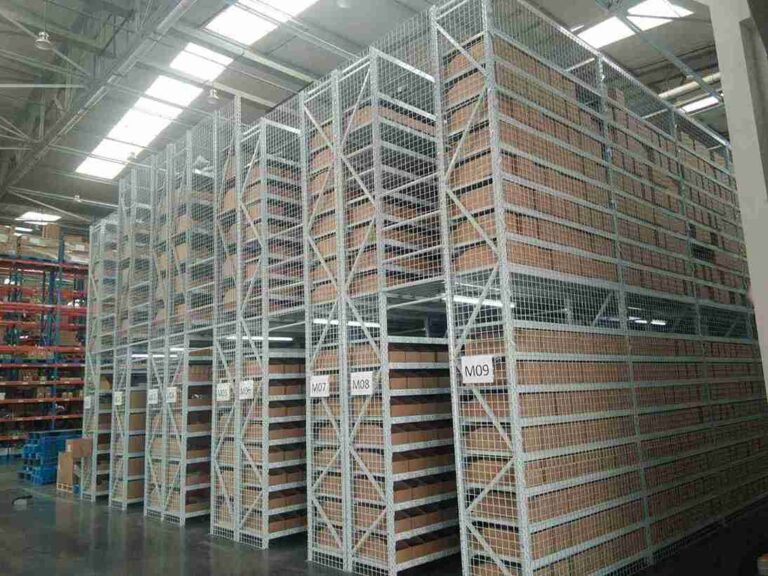📐 "First 50 Enterprise Queries Get Custom 3D Warehouse Design" Plan

Introduction: Why Rack Inspections for Narrow Aisles Are Critical
Narrow aisle warehouses maximize storage density, but they also introduce unique risks that demand rigorous rack inspections for narrow aisles. Without proper oversight, even minor damage can lead to catastrophic rack collapses, worker injuries, and costly operational disruptions. This guide provides a comprehensive, step-by-step approach to conducting rack inspections for narrow aisles, ensuring compliance with OSHA, RMI, and industry best practices.
For warehouse managers, safety officers, and logistics professionals, mastering rack inspections for narrow aisles is not optional—it’s a legal and operational necessity.

1. The Hidden Dangers of Neglecting Rack Inspections for Narrow Aisles
Narrow aisles (typically under 8 feet wide) amplify the risks associated with rack damage. Common hazards include:
- Forklift collisions causing bent uprights or dislodged beams
- Overloaded beams leading to gradual structural failure
- Misaligned racks increasing instability risks
- Corrosion and wear weakening load-bearing components
Without consistent rack inspections for narrow aisles, these issues can escalate into costly accidents, OSHA violations, and supply chain delays.
2. OSHA & RMI Compliance: The Legal Framework for Rack Inspections for Narrow Aisles
Regulatory bodies mandate strict guidelines for rack inspections for narrow aisles:
2.1 OSHA Requirements
- Annual professional inspections by qualified personnel
- Weekly visual checks by warehouse staff
- Immediate reporting of any damage
- Documented records for compliance audits
2.2 RMI Standards (ANSI MH16.1-2023)
- Upright deflection limits (no more than 0.5% of height)
- Beam connection integrity (no visible cracks or deformations)
- Anchorage stability (racks must be securely bolted)
Failing to follow these standards can result in fines, lawsuits, and increased insurance premiums.
3. Essential Tools for Effective Rack Inspections for Narrow Aisles
Inspecting racks in tight spaces requires specialized equipment:
3.1 Precision Measurement Tools
- Laser distance meters for checking rack alignment
- Ultrasonic thickness gauges to detect hidden corrosion
- Digital inclinometers to measure tilt angles
3.2 Inspection Aids for Hard-to-Reach Areas
- Flexible borescopes for examining beam connectors
- High-intensity LED lights for dark corners
- Magnetic inspection mirrors to spot rear damage
3.3 Load Verification Devices
- Load cell testers to confirm weight distribution
- Beam deflection gauges to monitor sagging
Using the right tools ensures accurate, efficient rack inspections for narrow aisles.
4. Step-by-Step Guide to Performing Rack Inspections for Narrow Aisles
4.1 Pre-Inspection Preparation
- Review past inspection reports for recurring issues
- Clear the aisle of pallets and debris
- Verify lighting conditions for optimal visibility
4.2 Visual Inspection Protocol
- Check uprights for dents, cracks, or bending
- Examine beam connectors for looseness or shearing
- Inspect base plates for shifting or bolt failure
- Look for rust, corrosion, or paint chipping
4.3 Structural Integrity Testing
- Measure deflection under load (must be within RMI limits)
- Test beam locks for secure engagement
- Verify floor anchors for stability
4.4 Post-Inspection Actions
- Tag damaged racks with color-coded labels (red = critical, yellow = monitor)
- Update digital logs with photos and notes
- Schedule repairs within 24 hours for critical damage
5. Common Rack Damage in Narrow Aisles & How to Address It
5.1 Forklift Impact Damage
- Symptoms: Bent uprights, twisted beams
- Solution: Install steel column guards or polyurethane protectors
5.2 Overloading & Beam Fatigue
- Symptoms: Excessive sagging, cracked welds
- Solution: Redistribute weight or upgrade to heavy-duty pallet racks
5.3 Corrosion & Metal Fatigue
- Symptoms: Rust, pitting, or flaking paint
- Solution: Apply industrial-grade epoxy coatings or replace compromised sections
6. Proactive Strategies to Minimize Rack Damage in Narrow Aisles
Prevention is cheaper than repairs. Key tactics include:
- Forklift operator training on narrow aisle navigation
- Speed limit enforcement (max 5 mph in aisles)
- High-visibility rack markings to prevent collisions
- Scheduled maintenance every 90 days
7. When to Hire a Professional for Rack Inspections for Narrow Aisles
While in-house checks are vital, experts should handle:
- Post-collision assessments
- Seismic zone compliance evaluations
- High-density storage configurations
Professional inspectors use 3D laser scanning and finite element analysis (FEA) for precision.
8. How Technology Enhances Rack Inspections for Narrow Aisles
Modern solutions include:
- AI-powered image recognition to auto-detect damage
- IoT vibration sensors for real-time monitoring
- Automated drone inspections for high elevations
These tools cut inspection time by 50% while improving accuracy.
9. Legal & Financial Risks of Poor Rack Inspections for Narrow Aisles
- OSHA fines up to $15,625 per violation
- Voided insurance claims if inspections are undocumented
- Workers’ compensation lawsuits from injuries
Proper documentation is the best defense.
10. Conclusion: A Safe Warehouse Starts with Rigorous Rack Inspections for Narrow Aisles
Narrow aisles demand more frequent, meticulous inspections than conventional layouts. By combining regular checks, staff training, and tech-driven solutions, warehouses can prevent disasters, ensure compliance, and extend rack lifespan.
For facilities prioritizing safety, rack inspections for narrow aisles should be a non-negotiable routine.
Frequently Asked Questions (FAQs)
1. How often should we conduct rack inspections for narrow aisles?
- Weekly for visual checks
- Quarterly for formal assessments
- Annually for professional evaluations
2. What’s the #1 mistake in rack inspections for narrow aisles?
Skipping beam connector checks—the most common failure point.
3. Can we repair a slightly bent upright, or must it be replaced?
If deflection exceeds 0.5% of height, replacement is mandatory.
4. Do narrow aisle racks have lower weight limits?
No, but misloads are more dangerous due to tighter clearances.
5. How can we train staff to spot rack damage?
Use interactive VR simulations and real-world case studies for engagement.
By implementing these strategies, warehouses can boost safety, compliance, and operational efficiency—one inspection at a time.




